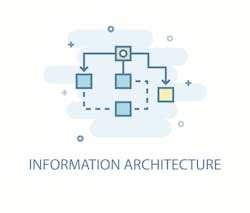Manufacturing organizations need information architecture before artificial intelligence
By Anand Mahurkar, CEO of Findability Sciences
Growth in manufacturing depends on continuously looking for new ways to increase earnings, reduce risks and errors, and improve production efficiency. Artificial intelligence-powered solutions machines are the perfect way to achieve these goals, as they enable companies to leverage their vast legacy of manufacturing data to automate complex tasks, self-optimize, and initiate independent decision-making.
AI in the manufacturing market is valued at $2.3 billion in 2022 and is projected to reach $16.3 billion by 2027. Post-pandemic, the demand for AI is surging, and not just in manufacturing. Many enterprises now see the need for AI to keep pace with the current business landscape. According to a recent PwC report, AI technology is estimated to contribute up to $15.7 trillion to the global economy by 2030 and will continue to change the game by accelerating productivity.
AI in the manufacturing arena can enable predictions with high accuracy, resource-requirement forecasting, and energy and commodity price predictions. But obstacles to smart implementation of AI strategies persist.
Consider this aspect: AI requires machine learning, machine learning requires analytics, and analytics requires the right data and information architecture (or IA). Simply put, there is no AI without IA.
AI solution-providers should aim to help organizations become data-driven so the organizations can leverage AI to the fullest and be able to use their data to drive insights and predictions. But for the organization to succeed in its AI journey, they have to prepare its system for AI innovation. This means working on their IA before the AI.
Not prioritizing the information architecture can prompt the AI journey to end up like the 60-80% of AI projects…failures. Many manufacturers are loaded with data but do not have the right infrastructure to make sense of it. Data needs to be collected, cleaned, and analyzed in order to be properly fed to algorithms; as you are likely aware, collection and data storage aren’t always handled properly.
There is also this complicating issue: many companies have invested in many diverse technologies but are not sure how to use these technologies to create an AI program. For instance, a company may have secured licenses with huge data companies such as IBM or Snowflake, but don’t know how to use them to create a sustainable AI program.
The vast majority of industrial organizations believe that data quality is an obstacle to their data integration projects. Most don’t analyze their data. Those that do spend too much time on data cleaning, integration and preparation. And most enterprises are hindered by data silos—data from different departments that isn’t shared with the whole organization.
Seeking AI solutions
The right AI-solution provider can help a manufacturing company in their AI journey by:
Creating a collaborative team: The AI solutions provider can team up with the organization's employees to create a network experts. The solutions provider can teach and train the employees on how to manage the AI program. Different experts can provide different insights into helping the company further its goals. This collaborative team can help create a roadmap for the company’s AI solutions.
Organizing an information architecture: Manufacturing organizations can get ahead by utilizing “wide data”—data with a healthy variety in terms of source, type and even format. Both structured and unstructured data constitute “wide data.” Collecting massive volumes of data—big data—isn’t enough for an AI journey to be successful. AI-solution providers can help the organization create an information architecture so they can leverage both wide and big data.
Implementing a partner strategy and cloud migration: A trend in the tech space is going from on-prem to cloud. On-premises is a means of deploying technology through hardware such as flash drives or CDs. Businesses have spent a fortune on tech the likes of an Oracle database or SQL database. But with cloud technology, software and licenses have become more accessible across multiple devices. Platforms such as Snowflake, EDB, Amazon Redshift, DB2, Netezza, and IIAS (IBM Integrated Analytics Systems) can help for a seamless AI journey by bringing both data and system to the cloud.
Since they have partnerships with these platforms, AI-solution providers can bring to the table all the technology, skills and expertise to help the company migrate to modern, cloud-based, data-storage solutions. They know how to connect all the technologies necessary for a flawless AI implementation, from planning to execution.
Conclusion
Overall, the AI journey for the manufacturing industry is still full of potholes. Manufacturing companies still struggle with data silos as well as faulty investments on technologies that are not AI-ready.
Manufacturing companies will greatly benefit from AI, but there are several steps they need to take in order to start their AI journey. Seeing the bigger picture—all the benefits the AI technology can offer the industry—should be a powerful motivator for manufacturing companies to push through with accelerating their digital transformations.
